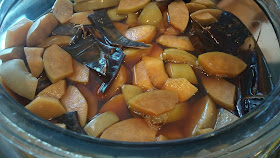 |
| Wild persimmons, green apples and honey locust pods. |
Honey locust beer recipes can be found in several antique reference books. I wanted to give it a try just to see how it would turn out. I have made wine many times but never beer. It turned out to be easy and produced a beer that resembles a dark fall-flavored specialty variety. I will definitely do it again in the future. Here is the original recipe:
Honey Locust Persimmon Beer Recipe
Ingredient:
Long black Honey Locust pods
Ripened persimmons or sliced apples
2 cups molasses or honey
Water
Directions:
Break pods into pieces. Place layer in keg or crock. Add persimmons or apples. Cover with boiling water. Add sweetener, let stand at least four days before using.
My notes: It was dilemma as whether to wash the pods or not since I was concerned for the natural yeast. Thus, I only washed the pods that really looked dirty to me (about half, lol). It turns out not to make a difference since I had to add yeast anyway. So in the future I would wash all the pods off.
Also, I used a two gallon crock/container. I alternated the layers with ingredients. I used a grocery store bag full of locust pods, a handfuls of persimmons, and three lbs of green apples. I used molasses and added two teaspoons of Redstar yeast. I mixed the molasses and hot water together before adding to the fruit to distribute it evenly. To add the yeast, I removed some of the liquid on day three since natural fermenting was not happening, warmed it slightly and mixed in the yeast. Then I returned it to the crock. It fermented for twelve days before bottling.
Broken honey locust pods.
Persimmon layer.
Sweet honey locust pulp.
Layers of ingredients.
On day three there was no fermentation so two teaspoons of yeast was added. It came to life on day four!
Day twelve fermenting had gone quiet.
Day twelve and ready to move to bottles.
Beer with carbonation!
Moving to bottles with great flavor and nice bubbles!



















